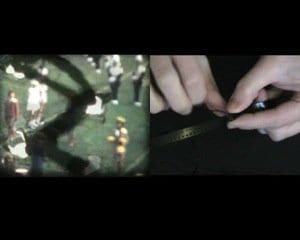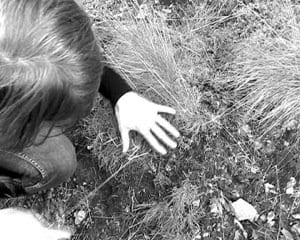An interview with Emma Osbourn.
1. Can you describe the artwork that you make?
I use a combination of textile processes, video and sound. I try to create a tension, allowing an interruption between the known and the unknown, provoking a perceptual disruption. Once these norms are disrupted this evokes a sense of familiar at the same time as evoking a sense of the strange.

2. How would you say that the MA changed your (approach to your) artwork?
With strong tutorial support I was able to ‘take my practice apart’ and question long-held assumptions and habits, I was then able to begin to reconstruct it. My practice was transformed by my time at Lincoln.
3. What do you think is the best thing you got from doing the MA Fine Art at the University of Lincoln?
Without a doubt, time; doing a formal educational course meant that I did not feel guilty about allotting time to my practice. Another important aspect was being part of a cohort; after working in isolation this adds a completely new dimension to the creative process. It really was key in my career path. It is a good route for anyone interested in continuing a career in a serious academic way.
4. What have you done since graduating?
I realised towards the end of my MA that I wanted to carry on with the research aspect of my practice as well as the practical part. Seeking a funded PhD was the next step, but getting on to one was the challenge. At that time I did not have a research question so I looked at all possibilities.
The first key thing was a 2-week residency in Scotland, which gave me time and space to think and be creative with no outside pressures. I also had a sound piece in an Arts Festival, which was a useful experience, as many things went wrong technically. I learned it is essential to be constantly on-site with public events. The work I did in Scotland was selected for a Film Festival, and I presented it as an installation.
I also knew I needed to get more experience of presenting and to have written work published. To enable this I applied for peer-reviewed conferences and symposia. I submitted abstracts for four different conferences and was accepted for two. Firstly, I wrote a paper and presented it in video form for an architecture conference, which led to my getting some teaching at Edinburgh University. I had a paper chosen for a textile conference in the US, that was problematic as it is almost impossible to get funding for conferences as an Independent. I spent as much time looking for funds as I did writing the paper. I am very glad I did these two papers as I learned so much about the writing process; it takes 3 times as long as you think it will! Then with these experiences behind me I stared to apply for PhDs. I had some interest from Manchester Met and then I found a funded one at Loughborough. Writing the application was the next challenge; that took 6 times as long as I thought it would. I applied and was interviewed and was given the place.
5. Can you talk a little of the transition from MA to PhD study?
I was really out of practice with writing so the most useful thing I did was writing the two papers. When you present at a Conference you realise that everything you say has to be carefully thought out and precisely delivered. The written version then has to be done just as rigorously. The PhD is a substantial extension of that. An MA offers a great chance for exploration and experimentation, whereas a PhD requires rigorous attention to detail and has far less possibility for free-ranging creative exploration.
Reparation from Emma Osbourn on Vimeo.
Triptych from Emma Osbourn on Vimeo.
Arachne’s Thread from Emma Osbourn on Vimeo.
To find out more about Emma’s work please visit her website here


